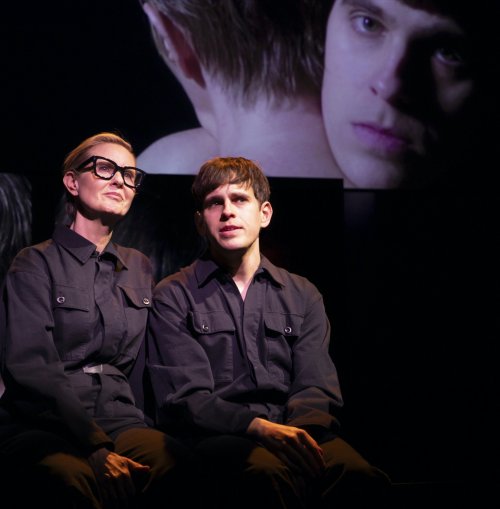
By: Darryl Reilly
Cynthia Nixon and Taylor Trensch are wearing black jump suits and silently sitting across from each other in semi-darkness when the audience arrives and waits for playwright Jordan Seavey’s engrossing contemporary family drama, The Seven Year Disappear to begin. This opening tableau is fitting as Ms. Nixon ferociously plays an acclaimed egotistical bipolar performance artist and Mr. Trensch sensitively plays her severely troubled substance-addicted gay son. Much is often comically made of their Jewishness; she is a WASP who converted to be in synch with his Jewish Bohemian father. Mr. Seavey’s scenario is poignant, insightful and suspenseful. Seavey’s knowing dialogue evokes the gleeful takedowns of the elitist art world contained in such Woody Allen masterpieces as Interiors, Manhattan and Hannah and Her Sisters. Resentment of Marina Abramović gets a lot of hilarious mileage, there are scornful references to the Whitney Museum, and the searing finale takes place at the Museum of Modern Art.
It is 2016 and Naphtali, a young gay man is working in Brooklyn for Hillary Clinton’s presidential campaign. His mother Miriam, a famous performance artist has been missing for the last seven years; he had been her manager and then survived on his own. Their dysfunctional relationship is further informed by Naphtali’s father having left the family when he was four years old. Miriam returns after this long traumatic absence refusing to explain why she disappeared or what she has been doing. Her strategic goal is for her and her son to perform a frank piece detailing their lives and relationship at the Museum of Modern Art, then on tour around the U.S. and the world at prestigigious institutions.
Seavey structures The Seven Year Disappear as short punchy nonlinear scenes which present Naphtali and Miriam’s lives and dramatizes their intense involvement. The perennial theme of the self-absorbed creator inflicting pain on their loved ones is given a fresh spin. The sharp dialogue piercingly presents family conflicts, the artworld milieu and the contemporary gay male metropolitan experience. Hookup apps, awkward dates and the threat of HIV, are vividly depicted. A standout scene is a feverish, chilling and humorous exchange at a crystal meth sex party; the host, an HIV positive Episcopal bishop wants to be called Daddy and wants the high and philosophically loquacious Naphtali to perform oral sex on him. This sequence’s queasiness is compounded by Nixon appearing as the gruff-voiced prelate.

Besides offering an exhilarating and emotionally precise portrayal of Miriam, Nixon gamely plays all the other male subsidiary characters instead of a third male actor. Miriam’s former German art dealer lover who is now having an affair with her son, an amorous co-worker of her son, and a swaggering suitor on a date with her son, are represented. Nixon vocally and physically transforms herself with confident subtly for these brief striking characterizations. This meta device enforces the notion that we are watching Miriam’s performance art piece and not a conventional realistic play. With his sunny countenance, distinctively emotive voice and beaming stage presence, Trensch offers a fearless performance as Naphtali. Whether conversing with his mother over his use of condoms, candidly embracing his sexuality or expressing anguish, Trensch is staggering and heartbreaking.
Director Scott Elliott guides his dynamic cast while successfully harnessing high-tech stagecraft for this arresting production which replicates the texture of the performance piece we’re supposed to be viewing. Derek McLane’s gleaming black-centric scenic design is the perfect terrain for this modern art centered tale. Projection designer John Narun’s museum-worthy video creations enhance the narrative. Jeff Croiter’s lighting design is appropriately kinetic. The aesthetic artistic dimension is completed by Rob Milburn and Michael Bodeen’s intense sound design. Fight and intimacy director’s UnkleDave’s Fight-House contributions are of uneasy authenticity. Costume designer Qween Jean’s sleek and lustrous black jump suits are ideal.

Cryptic at times but always intriguing, The Seven Year Disappear is a haunting theatrical experience.
The Seven Year Disappear (through March 31, 2024)
The New Group
The Pershing Square Signature Center: Alice Griffin Jewel Box Theater, 480 West 42nd Street, in Manhattan
For tickets, visit www.thenewgroup.org
Running time: 90 minutes with no intermission
